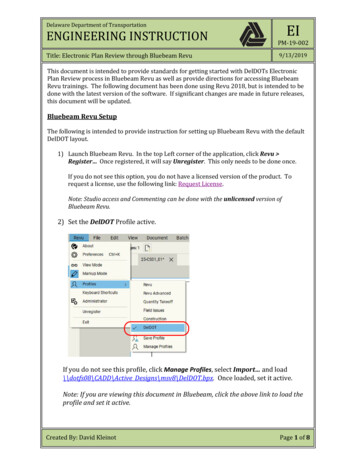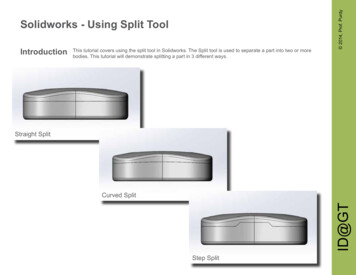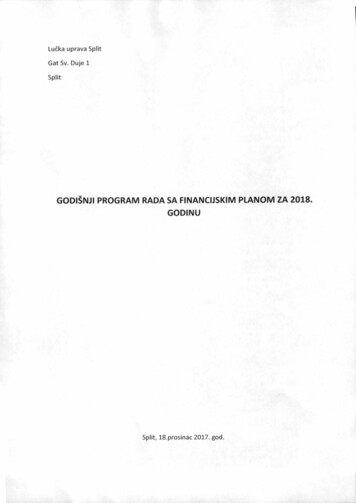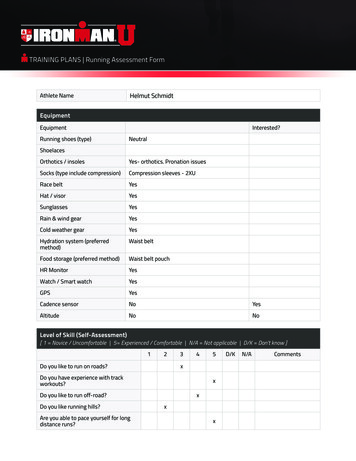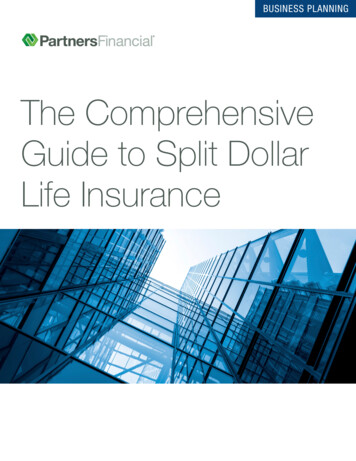
Transcription
BUSINESS PLANNINGThe ComprehensiveGuide to Split DollarLife Insurance
NFP BUSINESS PLANNING SERIES:THE COMPREHENSIVE GUIDE TO SPLIT DOLLAR LIFE INSURANCEThe world of split dollar life insurance agreements is a complicated one where old rules and regulationscollide with newly issued rules and regulations, leaving planners wondering what to do next. Given theconvoluted nature of the rules controlling split dollar life insurance agreements, there was no singlesource to turn to for answers — until now.NFP Life is proud to present “The Comprehensive Guide to Split Dollar Life Insurance.”NFP Life has always sought to provide the most relevant and useful tools to its members and producers.In keeping with that tradition, NFP Life teamed up with Greenberg Traurig to author the ultimate splitdollar resource. This industry-leading publication addresses all types of split dollar arrangements, bothpre- and post-final regulation, and the interplay of the split dollar rules with other related tax law in a userfriendly series of questions and answers.1
TABLE OF CONTENTSA. Overview of split dollar arrangements and this guideA.1.What Is Split Dollar?A.2.Why Use Split Dollar?A.3.What Is the Main Difference Between Business and Private Split Dollar Arrangements?A.4.What Rules Govern the Taxation of Split Dollar Arrangements?A.5.How to Use This GuideB. General Concepts in Structuring Split Dollar ArrangementsKEY COMPONENTSB.1.What Are the Key Components in a Split Dollar Arrangement?POLICY OWNERSHIPB.2.Who Owns the Policy Under a Split Dollar Arrangement?B.3.What Is the Endorsement Method?B.4.What Is the Collateral Assignment Method?B.5.Why Use the Endorsement Method Versus the Collateral Assignment Method?PREMIUMSB.6.Who Pays the Policy Premiums Under a Split Dollar Arrangement?B.7.What Is a Non-contributory Plan?B.8.What Is a Contributory Plan?B.9.What Is “Bonus” Split Dollar?POLICY EQUITYB.10.What Is Policy Equity?B.11.What Is an Equity Split Dollar Arrangement?B.12.What Is a Non-equity Arrangement?B.13.Why Use an Equity Arrangement Versus a Non-equity Arrangement?ECONOMIC BENEFIT AND LOAN REGIME SPLIT DOLLARB.14.What Do References to Economic Benefit or Loan Regime Split Dollar Mean?C. Grandfathered Split Dollar ArrangementsDEFINITIONSC.1.What Is a “Grandfathered” Split Dollar Arrangement?2
C.2.What Is the “Entered Into” Date for a Split Dollar Arrangement?C.3.What Does “Materially Modified” Mean for a Grandfathered Split Dollar Arrangement?FORMATION/STRUCTUREC.4.How Are Grandfathered Split Dollar Arrangements Typically Structured?C.5.How Are Equity and Non-equity Grandfathered Split Dollar Arrangements Identified?TAXATIONC.6.How Are Grandfathered Split Dollar Arrangements Taxed?C.7.How Is the Annual Economic Benefit Measured?C.8.What Term Insurance Rates Are Used to Determine the Annual Economic Benefit?C.9.Will Insurance Carriers Certify Their Insurer Term Rates for IRS Compliance?C.10.What Is the Impact of Using Table 2001 Rates Versus Insurer Term Rates to Determine theAnnual Economic Benefit?C.11.Does the Annual Economic Benefit Change Each Year?C.12.What Is the Impact of an Increasing Annual Economic Benefit?C.13.What Happens When the Policy Is Paid up or the Business No Longer Needs toAdvance Premiums?C.14.How Is the Annual Economic Benefit Taxed Under Contributory Plans?C.15.Does an Insured Receive Basis in the Policy for Reporting or Contributing the AnnualEconomic Benefit?C.16.Are Policy Dividends or Other Policy Benefits Taxed to the Insured UnderGrandfathered Arrangements?C.17.How Is Policy Equity Taxed?C.18.What Does “No-inference” Mean with Regard to the Taxation of Policy Equity?C.19.What Are the Tax Consequences if an Insured’s Trust Owns the Policy?C.20.Do Imputed Gifts of the Annual Economic Benefit to an ILIT Qualify for the Annual Exclusion fromGift Tax?C.21.How Is the Imputed Income from the Arrangement Taxed to the Insured?C.22.Can the Business Take a Deduction for Premiums Paid Under a Grandfathered SplitDollar Arrangement?C.23.Are the Death Benefits Paid from the Policy Under a Grandfathered Split Dollar ArrangementIncome-tax-free?MATERIAL MODIFICATIONSC.24.What About “Material Modifications” to Grandfathered Split Dollar Arrangements?C.25.Why Does a Material Modification Matter?C.26.What Qualifies as a Material Modification?3
C.27.What Are the Tax Consequences of the Loss of Grandfathered Status?C.28.Does a 1035 Exchange Constitute a Material Modification?C.29.Will the IRS Privately Rule on What Qualifies as a Material Modification?C.30.Should 1035 Exchanges Still Be Considered for Grandfathered Arrangements?MAINTENANCE AND ADMINISTRATIONC.31.Should a Grandfathered Split Dollar Arrangement Be Maintained?C.32.What Are the Administration and Maintenance Requirements for Grandfathered SplitDollar Arrangements?EXITS/TERMINATIONS/ROLLOUTSC.33.What Is an “Exit,” a “Termination” or a “Rollout”?C.34.Why Are Exits Important for Grandfathered Split Dollar Arrangements?C.35.What Are the Key Factors in Selecting and Implementing an Exit Strategy?C.36.What Are Potential Exit Strategies for a Grandfathered Arrangement?CASE STUDIESC.37.Rollout from a Grandfathered Collateral Assignment Split Dollar (with Equity)C.38.Rollout from a Grandfathered Collateral Assignment Split Dollar (No Policy Equity)C.39.Termination of a Grandfathered Collateral Assignment Split Dollar (with Equity) and 162 Bonus ofthe Corporate Interest in the PolicyD. Post-regulation Split Dollar ArrangementsDEFINITIONSD.1.What Is a “Post-regulation” Split Dollar Arrangement?D.2.What Do the Terms “Entered into” and “Materially Modified” Mean for Purposes of the FinalRegulations?D.3.What Is a “Split Dollar Arrangement” Under the Final Regulations?D.4.What Arrangements Are Not Split Dollar Arrangements?D.5.Who Is the “Owner” of a Policy Under a Split Dollar Arrangement?D.6.Who Is a “Non-owner”?D.7.Why Does Policy Ownership Matter?TAXATIOND.8.How Are Split Dollar Arrangements Taxed Under the Final Regulations?D.9.How Are Split Dollar Arrangements Taxed for Estate Tax Purposes?ECONOMIC BENEFIT REGIMED.10.How Does the Economic Benefit Regime Tax Split Dollar Arrangements?4
D.11.What Are Recognizable Economic Benefits Under the Economic Benefit Regime?D.12.What Is the Cost of Current Life Insurance Protection Under the Economic Benefit Regime?D.13.How Is the Cost of Current Life Insurance Protection Calculated Under a SplitDollar Arrangement?D.14.What Is the Amount of Current Life Insurance Protection Provided Under a SplitDollar Arrangement?D.15.What Is the Impact of Using Table 2001 Rates Versus Insurer Term Rates to Calculate the Costof Current Life Insurance Protection?D.16.Will Insurance Carriers Certify Their Insurer Term Rates for IRS Compliance?D.17.Will the Cost of Current Life Insurance Protection Increase Each Year?D.18.What Is the Impact of the Increasing Cost of Current Life Insurance Protection?D.19.What Happens When the Policy Is Paid Up or the Business No Longer Needs toAdvance Premiums?D.20.What Is Current Access to Policy Cash Value (Equity Arrangements)?D.21.When Does the Non-owner Have Direct or Indirect Access to Policy Cash Value?D.22.How Is the Value of Current Access to Policy Cash Value Calculated?D.23.Can the Policy Cash Value or the Valuation Date Be Adjusted to Limit or Reduce the Value of theNon-owner’s Current Access to Policy Cash Value?D.24.How Are Economic Benefits Taxed Under a Contributory Arrangement?D.25.Does the Non-owner Receive Basis in the Policy Under a Contributory Arrangement?D.26.How Are Distributions, Loans or Other Non-death Benefit Proceeds Received Under the PolicyTaxed in the Economic Benefit Regime?D.27.Can the Business Take a Deduction for Premiums Paid Under an Economic Benefit SplitDollar Arrangement?D.28.How Are Policy Death Benefits Taxed Under The Economic Benefit Regime?D.29.What Are The Tax Consequences Upon a Transfer of the Policy to the Non-Owner?D.30.What Is the Policy’s Fair Market Value for Purposes of a Transfer from an Owner to theNon-owner?D.31.What Is the Non-owner’s Investment in the Contract After a Transfer of the Policy to theNon-owner?D.32.How Is the Income from the Split Dollar Arrangement Taxed to the Insured?D.33.What Are the Tax Consequences if an ILIT Owns or Has an Interest in the Policy Under theEconomic Benefit Split Dollar Arrangement?D.34.Do Imputed Gifts of Economic Benefits to an ILIT Qualify for the Annual Exclusion from Gift Tax?LOAN REGIMED.35.When Does the Loan Regime Apply to Split Dollar Arrangements?5
D.36.How Does the Loan Regime Tax Split Dollar Arrangements?D.37.What Payments Create Split Dollar Loans Under Loan Regime Split Dollar Arrangements?D.38.What Is a “Reasonable Expectation” of Repayment for a Split Dollar Loan?D.39.What if There Is No Reasonable Expectation of Repayment?D.40.Are Most Split Dollar Loans Considered Nonrecourse for Purposes of the Final Regulations?D.41.What Is the Impact of Having a Nonrecourse Split Dollar Loan?D.42.Can Parties to a Nonrecourse Split Dollar Loan Avoid Contingent Payment Treatment?D.43.What Is Adequate Interest for Purposes of Testing a Split Dollar Loan?D.44.What if a Split Dollar Loan Does Not Charge Adequate Interest?D.45.What Is a Split Dollar Demand Versus a Term Versus a Hybrid Loan?D.46.How Is a Split Dollar Demand Loan Tested for Adequacy of Interest?D.47.How Is a Below-market Split Dollar Demand Loan Taxed?D.48.How Are Split Dollar Term Loans Tested for Adequacy of Interest?D.49.How Is a Below-market Split Dollar Term Loan Taxed?D.50.How Are the Term and Adequacy of Interest Determined for Split Dollar Hybrid Loans?D.51.What Happens if a Split Dollar Hybrid Loan Exceeds Its Original Term?D.52.What if the Non-owner/Business Forgives, Cancels, Waives or Otherwise Pays the OutstandingInterest on a Split Dollar Loan?D.53.What if the Non-owner/Business Waives or Forgives Repayment of Loan Principal?D.54.How Is the Non-owner/Business Taxed on Interest and Other Payments Under a SplitDollar Loan?D.55.Who Accrues Policy Basis/Investment in the Contract for Premiums Paid Under SplitDollar Loans?D.56.How Is the Owner Taxed on Distributions, Withdrawals, Death Benefits or Other ProceedsReceived from the Policy Underlying the Split Dollar Loan?D.57.Can the Non-owner/Business Deduct Premium Payments?D.58.How Is Imputed Income Under a Split Dollar Loan Taxed to the Insured?D.59.Can the Policyowner, as Borrower, Deduct Interest on the Split Dollar Loan?D.60.What if a Below-market Split Dollar Loan Is Made to a Third-party Owner (e.g., theInsured’s Trust)?FORMATION AND ADMINISTRATIOND.61.What Is the Typical Structure for Economic Benefit Split Dollar Arrangements?D.62.Why Use an Endorsement Arrangement Versus a Non-equity CollateralAssignment Arrangement?6
D.63.What Are the Formation Requirements for Economic Benefit Arrangements?D.64.What Are the Maintenance Requirements for Economic Benefit Arrangements?D.65.How Are Split Dollar Loans Typically Structured?D.66.Why Use a Demand Versus a Term Versus a Hybrid Split Dollar Loan?D.67.What Are the Formation and Administrative Requirements for a Split Dollar Loan?D.68.What Are the Maintenance Requirements for a Split Dollar Loan?SELECTING REGIMESD.69.What Are the Main Factors in Selecting a Split Dollar Regime?D.70.When Should the Business and Insured Consider the Economic Benefit Regime?D.71.When Should the Business and Insured Consider a Split Dollar Loan?D.72.Are There Special Considerations for Split Dollar Arrangements Between Corporations andMajority Shareholders?PRODUCT CONSIDERATIONSD.73.Why Are Cash Value Products Often Used in Split Dollar Arrangements?D.74.Should a MEC Be Used in a Split Dollar Arrangement?D.75.Are There Any Issues with Using Split Dollar Loans in Conjunction with Variable Policies?EXIT/TERMINATION/ROLLOUTD.76.What Is a Split Dollar “Exit,” “Termination” or “Rollout”?D.77.Why Are Exits Important for Split Dollar Arrangements?D.78.What Are the Key Factors in Selecting and Implementing an Exit Strategy for a SplitDollar Arrangement?D.79.What Are Potential Exit Options for a Split Dollar Arrangement?D.80.What if Additional Premiums Are Required on the Policy After the Exit?CASE STUDIESD.81.Loan Regime Split Dollar Between Business, as Employer, and Insured Executive’s ILIT —First YearD.82.Termination of a Loan Regime Split Dollar (with Equity)D.83.Termination of a Loan Regime Split Dollar (Without Equity)E. Other Issues Under the Tax CodeIRC § 409A AND TAXATION OF NONQUALIFIED DEFERRED COMPENSATION ARRANGEMENTSE.1.What Is IRC § 409A?E.2.When Did IRC § 409A Take Effect and Are There Any “Grandfathering” Protections?E.3.Does IRC § 409A Apply to Split Dollar Arrangements?7
E.4.What Happens if a Split Dollar Arrangement Is Not in Compliance with § 409A?E.5.What Specific Types of Compensatory Split Dollar Arrangements Are Affected by IRC § 409A?E.6.What Happens to Compensatory Equity Arrangements That Were in Place Before the EffectiveDate of IRC § 409A?E.7.How Are § 409A Grandfathered Benefits Taxed upon the Lifetime Termination of a CompensatoryEquity Split Dollar Arrangement?IRC § 101(J) AND TAXATION OF EMPLOYER-OWNED LIFE INSURANCE (EOLI)E.8.What Is an EOLI Contract?E.9.Does the EOLI Classification Apply to All Policies Meeting the EOLI Requirements, Regardless ofWhen Issued?E.10.What Are the Consequences to EOLI Contract Status?E.11.Are Policies Underlying Split Dollar Arrangements EOLI Contracts?E.12.Are There Any Exceptions to Death Benefit Inclusion for EOLI Contracts?E.13.What Are the Notice and Consent Requirements for Taking Advantage of the Exceptions to EOLIContract Taxation?E.14.Are There Any Corrective Actions the Employer Can Take if It Fails to Obtain the Employee’sNotice and Consent Prior to Policy Issuance?E.15.Are There Any Reporting Requirements Associated with EOLI Contracts?SARBANES-OXLEY ACT OF 2002E.16.How Does Sarbanes-Oxley Impact Split Dollar Planning?Appendix of Charts and Select Sample FormsAP.1.CHART: Decision Tree for Grandfathered Split Dollar ArrangementsAP.2.CHART: Taxation — Grandfathered Versus Post-regulation ArrangementsAP.3.CHART: Post-regulation Arrangements — Economic Benefit Versus Loan RegimeAP.4.CHART: Post-regulation Split Dollar — Types of Split Dollar LoansAP.5.CHECKLIST: Review Need for and Maintenance of Grandfathered Split Dollar ArrangementAP.6.CHECKLIST: Formation/Documentation of Economic Benefit Split Dollar ArrangementAP.7.CHECKLIST: Formation/Documentation of a Split Dollar Loan ArrangementAP.8.CHECKLIST: Questions for Reviewing/Selecting Split Dollar Exit StrategiesAP.9.SAMPLE FORM: Nonrecourse Representation for Post-regulation Split Dollar LoanAP.10. SAMPLE FORM: Notice and Consent Form for IRC § 101(j) Employer-owned Life Insurance8
DISCLAIMERS AND COPYRIGHTLegal Disclaimer. This work and any forms and agreements herein are intended for educational andinformational purposes only and not for use as legal, tax or financial advice. This work cannot be used byany taxpayer for the purpose of avoiding penalties that may be imposed on such taxpayer. Nothingcontained in this work is to be considered as the rendering of legal, tax or financial advice, eithergenerally or in connection with any specific issue, question or case. Readers are responsible for obtainingindependent legal, tax or financial advice from their own lawyers or other professionals or advisors.Financial Disclaimer. Any projections and illustrations provided herein are hypothetical approximationsonly, based on various factual, actuarial and tax assumptions. Actual results will vary and cannot beguaranteed. The authors do not sell investment or financial products nor provide financial or investmentadvice. 2014 Jonathan M. Forster and Jennifer M. Smith (“Authors”). All rights reserved. This work may be used, reproduced, stored in aretrieval system, or transmitted in any form or by any means, electronic, mechanical, photocopying, recording or otherwise, by NFPCorp. (“NFP”) (including branding with and transmission under the name of NFP) solely for the distribution to NFP and its ownedand member firms (“NFP Firms”) and the owners and employees of NFP and the NFP Firms. This work may not otherwise be used,reproduced, stored or transmitted without the express written consent of the Authors. No alterations, modifications, additions orsupplements may be made to, or provided for, this work without the express written permission of the Authors.9
THE COMPREHENSIVE GUIDE TO SPLIT DOLLAR LIFE INSURANCESection A: Overview of Split-Dollar Arrangements and This GuideA.1.What Is Split-Dollar?A split-dollar arrangement is an agreement between two parties (such as a business and employee) tosplit the costs and benefits of a life insurance policy insuring the life of one of the parties (e.g., theemployee).One party funds all or most of the policy premiums, retaining a right to repayment upon termination of thearrangement, which is generally paid from or secured by the proceeds of the policy.At the death of the insured, or the prior termination of the arrangement (sometimes referred to as splitdollar “exit” or “rollout”), the premium advancer is reimbursed for the premiums it paid, plus any additionalamounts required by the agreement, while the other party retains the remaining death benefit or, in thecase of a lifetime termination, the policy (and depending on the arrangement, any remaining policy cashvalue).A.2.Why Use Split-dollar?The general goal behind a split-dollar arrangement is to lower the cost and/or tax burden of providinginsurance coverage to the benefited party (i.e., the insured and/or the policy beneficiary).The specific reasons for using a split-dollar arrangement depend in large part on whether thearrangement is entered into for business or private purposes. Business split-dollar arrangements (the1focus of this guide) involve a business (typically a private, closely held or family-owned business) and anowner or key employee and can be designed to achieve a wide variety of business planning and/orsuccession goals. For example: Compensation/Benefits: A business may enter into a split-dollar arrangement as part of acompensation package to recruit, retain and reward key employees, executives and officers.Depending on the structure of the arrangement, the insured receives death benefit protection andmay also have ownership of the policy, including rights to cash value in excess of any amountsowed to the business to reimburse it for premiums paid on the policy.Retirement Benefits/Deferred Compensation: A business also may use a split-dollararrangement in conjunction with a nonqualified deferred compensation arrangement, in which thebusiness uses life insurance to informally fund future compensation payments or retirementbenefits on a tax-efficient basis. For example, the business may use the cash value of a policypurchased on an executive or key employee to fund retirement benefits for the insured, asthrough a supplemental executive retirement plan (SERP). At the insured’s retirement, the2business may access the cash value to pay the benefit.Buyout Funding: A business and its owners may enter into split-dollar arrangements to acquirelife insurance that will support the buyout of a business owner at death. For instance, in “crosspurchase” arrangements, each owner of the business buys life insurance on the other business1Since implementation of the Sarbanes-Oxley Act of 2002 (“SOX”) and its restrictions on loans by public corporations to coveredexecutives and directors, split-dollar arrangements have become far less common in a public company context. See Question E.16for a discussion of the impact of SOX on split-dollar arrangements.2Note that the SERP arrangement and agreement will need to comply with IRC § 409A. See the discussion beginning at QuestionE.1 for a more detailed review of IRC § 409A.10
owner(s). If an owner dies, the surviving owner(s) must use the life insurance proceeds topurchase the deceased owner’s interests. The business can enter into a split-dollar arrangementwith each owner to pay part of the premium due on the policies purchased, retaining areimbursement right for the amounts paid. This arrangement may assist if there are premiumdisparities among the policies due to age or health conditions of the various owners (e.g., oneowner must pay more for a policy insuring another owner who is older or ill).In a private context, split-dollar arrangements are designed to advance estate or wealth transfer planninggoals and generally involve family members or trusts for their benefit. For example, an insured/grantorwill often enter into a split-dollar arrangement with his or her irrevocable life insurance trust (ILIT) in orderto reduce the potentially taxable contributions that the grantor must make to the ILIT to fund policypremiums.A.3.What Is the Main Difference Between Business and Private Split-dollarArrangements?Apart from the different motivations for using a split-dollar arrangement, the main difference betweenbusiness and private split-dollar arrangements is that the tax consequences related to typical privatearrangements will be gift tax- rather than income tax-related. Otherwise, many of the same issues andconsiderations apply to both business and private split-dollar arrangements, and, in some cases, theplanning goals will converge. For example, a business executive who wants to avoid inclusion of the lifeinsurance death benefits in her estate may create an ILIT to receive or own the policy death benefits. Toprovide an added benefit to the executive (e.g., assistance with her estate planning goals), the businessmay enter into the split-dollar arrangement with the executive’s ILIT rather than the executive. Asdiscussed further in this guide, any income tax consequences from the arrangement will still apply to theexecutive, with corresponding gift taxation of the deemed transfer of benefits from the executive to herILIT.A.4.What Rules Govern the Taxation of Split-dollar Arrangements?Effective Sept. 17, 2003, the IRS issued final Treasury Regulations regarding the employment, income3and gift taxation of split-dollar arrangements (the “final regulations”). Accordingly, the tax rulesapplicable to a particular split-dollar arrangement largely depend on the date the parties entered into the4arrangement :3 Split-dollar arrangements entered into on or before Sept. 17, 2003, and not materially modifiedthereafter (grandfathered split-dollar arrangements) are governed by a series of RevenueRulings, Notices and other guidance issued by the IRS prior to the final regulations (pre5regulation guidance). Split-dollar arrangements entered into or materially modified after Sept. 17, 2003, (post6regulation split-dollar arrangements) are subject to taxation based on the final regulations.See T.D. 9092, 68 Fed. Reg. 54,336 (Sept. 17, 2003).4See Question C.2 for a definition of “entered into” for purposes of determining application of the final regulations to a split-dollararrangement.5See Rev. Rul. 55-747 (revoked by Notice 2001-10); Rev. Rul. 64-328, as amplified by Rev. Rul. 66-110 and Rev. Rul. 78-420, andmodified by Notice 2001-10 (generally the seminal ruling for taxing grandfathered split-dollar arrangement based on an “economicbenefit” theory, the ruling was obsoleted for split-dollar arrangements entered into or materially modified after Sept. 17, 2003, byRev. Rul. 2003-105); Rev. Rul. 66-110, as amplified by Rev. Rul. 67-154 and Rev Rul. 78-420, and modified by Notice 2001-10(obsoleted by Rev. Rul. 2003-105 for post-regulation split-dollar arrangements); Notice 2001-10, which revoked Rev. Rul. 55-747and modified Rev. Ruls. 64-328 and 66-110 (this Notice was revoked by Notice 2002-8, except for the modifications made by Notice2001-10 to Rev. Rul. 64-328 and Rev. Rul. 66-110 to the extent that those revenue rulings indicate that an employer's premiumpayments under a split-dollar arrangement may not be treated as loans); and Notice 2002-8 (while revoking Notice 2001-10, Notice2002-8 provides that taxpayers may rely on either Notice 2001-10 or Notice 2002-8 for split-dollar arrangements entered into beforeSept. 17, 2003 (see also T.D. 9092, 68 Fed. Reg. 54336 (9/17/03)). Accordingly, taxpayers may rely on Rev. Ruls. 64-328 and 66110, as modified by Notice 2001-10, for grandfathered split-dollar arrangements, to the extent described in Notice 2002-8. Partiesmay also rely on the proposed regulations, if certain requirements are met (see 67 Fed. Reg. at 45422).6Regs. § 1.61-22(j)(1) and (2).11
Given the significant differences that exist in taxation between grandfathered and post-regulation splitdollar arrangements, this guide separately analyzes the taxation, formation, administration andtermination of each type of split-dollar arrangement, including changes to grandfathered arrangementsthat can trigger application of the final regulations.See Appendix AP.2 for a chart comparing grandfathered and post-regulation split-dollar arrangements.A.5.How to Use This GuideThis guide is organized as a series of questions and answers that address common tax issues associatedwith grandfathered split-dollar arrangements and post-regulation split-dollar arrangements, which areused in a business or employment context. Citations to applicable source materials and technicalcomments are noted at the end of each section. An appendix with comparison charts and select sampleforms is included for convenience and reference.12
Section B: General Concepts in Structuring Split-dollar ArrangementsKEY COMPONENTSB.1.What Are the Key Components in a Split-dollar Arrangement?While there are numerous variations in split-dollar arrangements, their structure and documentationdepend primarily on three major factors:1. The ownership of the life insurance policy (policy)2.The split of premium payments on the policy3.The division of policy equityPOLICY OWNERSHIPB.2.Who Owns the Policy Under a Split-dollar Arrangement?Depending on the ownership structure selected, the business, the insured employee or business owner(the insured), or a third party chosen by the insured, such as his or her ILIT, is named as the owner onthe policy. The most typical ownership structures are the endorsement method, where the business is thenamed policy owner, and the collateral assignment method, where the insured (or, commonly, his or her7ILIT) is the designated policyowner.Note that the final regulations may treat the business as the “deemed” policy owner for purposes oftaxation of the split-dollar arrangement, even if the insured or the insured’s ILIT is actually named asowner on the policy (e.g., as in a non-equity split-dollar arrangement (discussed in Question B.12)entered into between a business and employee, where the only benefit to the employee is current life8insurance protection).B.3.What Is the Endorsement Method?In an endorsement split-dollar arrangement, the business owns and is the beneficiary of the policy on the9insured. The business files a policy endorsement with the issuing insurance carrier, endorsing theinsured’s interest in the policy death benefit (i.e., amounts in excess of the premiums advanced by thebusiness). The insured has the sole right to designate the beneficiary for the endorsed portion of thedeath benefit.7Other, less-common ownership structures include 1) the unsecured method and 2) the co-ownership method. The unsecuredmethod involves a purely contractual arrangement between the parties where the policy is not used to secure the business’repayment right. This approach may minimize some problems associated with the traditional methods (such as the appearance of aloan), but the income tax treatment of the benefits provided to the employee is uncertain. The co-ownership method dividesownership of both the policy cash value and death benefit between the business and the employee (or other third-party owner),which attempts to address the potential taxation of the policy equity to the employee (as discussed at Questions C.17 and C.18).The income tax impact of the arrangement is uncertain, however, and the arrangement is not conducive to managing the estate taxexposure of the insured if he or she is the controlling shareholder of the business. Both methods are deemed split-dollararrangements for purposes of the final regulations. For a more detailed discussion of these alternate documentation arrangements,see Brody, Richey, and Baier, 386-4th BNA T.M Portfolio, Insurance-Related Compensation, Art. IV.B.2.8See Questions D.5 and D.6 for a detailed discussion of the rules identifying the “owner” and “non-owner” of a policy under thefinal regulations.9Note that whenever a business entity owns a life insurance policy, including under a policy subject to the terms of a split-dollararrangement, the potential application of IRC § 101(j) should be reviewed. IRC § 101(j) provides for the income taxation of deathbenefits paid to owners of certain “employer-owned life insurance” contracts insuring the life of a business’ employee or other keyindividuals. Tax can be avoided in most situations if certain notice and consent requirements are met prior to contract issuance. IRC§ 101(j) does not apply to policies issued prior to April 18, 2006, or received in an IRC § 1035 exchange for a policy issued prior tothat date unless there is a material increase in the death benefit or other material change to the contract. See Questions E.8-E.15for a detailed discussion of IRC § 101(j) and the potential application to policies involving split-dollar arrangements.13
B.4.What Is the Collateral Assignment Method?Under a typical collateral assignment split-dollar arrangement, the insured (or, more commonly, theinsured’s ILIT) owns the policy and designates the beneficiary. The business pays the agreed-uponportion of the premiums, as specified in the split-dollar arrangement. The insured files a collateralassignment of the policy with the issuing
D.14. What Is the Amount of Current Life Insurance Protection Provided Under a Split Dollar Arrangement? D.15. What Is the Impact of Using Table 2001 Rates Versus Insurer Term Rates to Calculate the Cost of Current Life Insurance Protection? D.16. Will Insurance Carriers Certify Their Insurer Term Rates for IRS Compliance? D.17.



